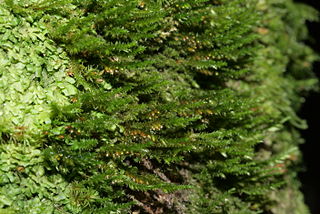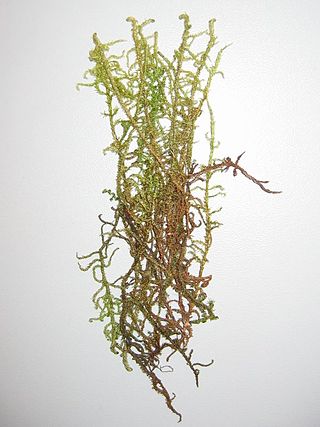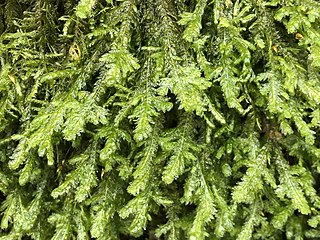Neckeropsis is a genus of plant in the family Neckeraceae.
Pinnatella is a genus of moss in family Neckeraceae.

Thamnobryum is a genus of moss in the family Neckeraceae. There are about 50 species. The genus is distributed throughout the world.

Hypnaceae is a large family of moss with broad worldwide occurrence in the class Bryopsida, subclass Bryidae and order Hypnales. Genera include Hypnum, Phyllodon, and Taxiphyllum.

Neckeraceae is a moss family in the order Hypnales. There are about 200 species native to temperate and tropical regions. Most grow on rocks, or other plants.

Barbula is a genus of mosses in the family Pottiaceae.

Cryphaea is a genus of mosses, (Bryophyta), containing at least 26 accepted species.

Syntrichia is a large, cosmopolitan genus of mosses in the family Pottiaceae. The genus name is of Greek origin for "plus" and "hair", referring to the "twisted peristome united by a basal membrane".

Alleniella complanata is a species of moss belonging to the family Neckeraceae.

Neckera is a large genus of mosses belonging to the family Neckeraceae. The genus was first described by Johann Hedwig. The genus has a cosmopolitan distribution.

Rhynchostegium is a genus of pleurocarpous mosses belonging to the family Brachytheciaceae. The genus has a cosmopolitan distribution across different climatological regions except the polar regions, mostly in tropic to north temperate regions. The genus contains both aquatic and terrestrial species. The genus was named for their rostrate opercula. The type species of this genus is Rhynchostegium confertum (Dicks.) Schimp.
Campylium is a genus of mosses belonging to the family Amblystegiaceae.

Drepanocladus is a genus of mosses belonging to the family Amblystegiaceae. It has a cosmopolitan distribution

Exsertotheca is a genus of mosses belonging to the family Neckeraceae.
Pylaisia is a genus of mosses belonging to the family Pylaisiaceae.
Platygyrium is a genus of mosses belonging to the family Hypnaceae.
Orthothecium is a genus of mosses belonging to the family Hypnaceae.

Leskeaceae is a family of mosses belonging to the order Hypnales.

Fabroniaceae is a family of mosses belonging to the order Hypnales. It has a worldwide distribution, in temperate and tropical regions.













